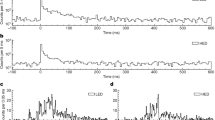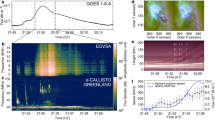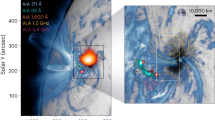Abstract
IT has been established from observation that chromospheric flares are closely associated with sunspots, and that the probability of a flare occurring near a spot ncreases with the size of the latter. The probability is higher when the group is increasing its size than when it is stationary, and it is also higher for magnetically complex βγ and γ-groups than for the simpler α- and β-type groups1. The flares themselves are short-lived phenomena, of mean life about thirty minutes, and are quite localized. It is generally accepted that they show no velocity either in height or across the surface of the sun.
This is a preview of subscription content, access via your institution
Access options
Subscribe to this journal
Receive 51 print issues and online access
$199.00 per year
only $3.90 per issue
Buy this article
- Purchase on Springer Link
- Instant access to full article PDF
Prices may be subject to local taxes which are calculated during checkout
Similar content being viewed by others
References
Giovanelli, R. G., Astrophys. J., 89, 555 (1939).
Chapman, S., Mon. Not. Roy. Ast. Soc., 103, 117 (1943).
Chapman, S., and Cowling, T. G., "The Mathematical Theory of Non-Uniform Gases", 327 (Cambridge University Press, 1939).
Cillié, G. G., and Menzel, D. H., Harvard College Observatory Circular 410 (1935).
Cowling, T. G., Proc. Roy. Soc., 183, 453 (1945).
Observatory, 66, 230 (1946).
Author information
Authors and Affiliations
Rights and permissions
About this article
Cite this article
GIOVANELLI, R. A Theory of Chromospheric Flares. Nature 158, 81–82 (1946). https://doi.org/10.1038/158081a0
Issue Date:
DOI: https://doi.org/10.1038/158081a0
This article is cited by
-
A happy ending for SADs
Nature Astronomy (2022)
-
Kinetic properties of collisionless magnetic reconnection in space plasma: in situ observations
Reviews of Modern Plasma Physics (2022)
-
Fluid and kinetic aspects of magnetic reconnection and some related magnetospheric phenomena
Reviews of Modern Plasma Physics (2020)
-
Using topology to locate the position where fully three-dimensional reconnection occurs
SN Applied Sciences (2020)
-
Particle Acceleration Due to Coronal Non-null Magnetic Reconnection
Solar Physics (2017)
Comments
By submitting a comment you agree to abide by our Terms and Community Guidelines. If you find something abusive or that does not comply with our terms or guidelines please flag it as inappropriate.



